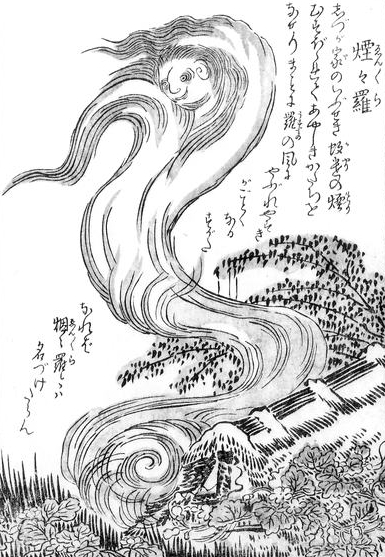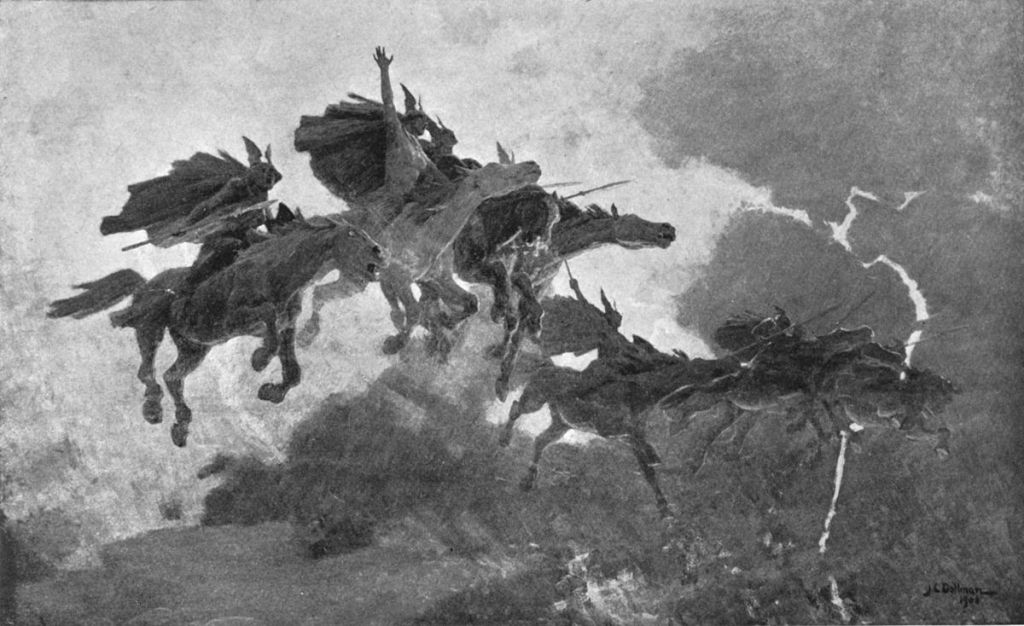
As long as you’re not driving your car on a zigzag road on a misty morning, mist can be beautiful, mysterious and sometimes even magical.
There’s always this sense that something otherworldly might be hidden behind that cloudy veil. The idea that mist is something more than just tiny droplets of water that are suspended into the air is something that can be found in folklore and mythology too. So, here’s a brief list of some mythological worlds and folkloric creatures who are associated with mist or smoke.
Féth fíada

The Tuatha Dé Danann are an elvish supernatural race from Irish mythology. They play a prominent role in many fascinating tales and I would like to explore these in a later blog post, but for now I would like to focus on something called the féth fíada. This word is used to describe a kind of mist that ensures that the Tuatha Dé Danann are invisible to the human race. This magical mist appears in the story of Manannán mac Lir who is a king of the Otherworld and also known as a son of the sea. According to legend he uses the féth fíada to cloak the dwellings that belong to the Tuatha Dé Danann so that they cannot be found by humans.
This magical mist also might appear in the Lebor Gabála Érenn, although it’s a bit unclear. The Lebor Gabála Érenn is a medieval collection of poems that tells the story of the history of Ireland. It begins with the creation of the world and ends during the early middle ages. According to this text the Fir Bolg were the fourth group of settlers to live in Ireland until the Tuatha Dé Danann arrived in ships that were hidden in ‘clouds of fog.’ It’s uncertain if this is another reference to the féth fíada since the text explains that these clouds were there because they had set their own ships on fire. Faking mist could have been the elvish way to start a surprise attack. They defeated the Fir Bolg and ruled Ireland for the next 150 years.
Witte Wieven

Witte Wieven are the spirits of wise women from Dutch folklore. They’re very ambiguous. Depending on where you go and who you ask, they’re believed to be either elves, fairies, ghosts, witches, women of the swamp, omens of death, midwives, abductors or a mixture of some of these. They love to dance around hills, they live in dolmen or cairns, and they’re very fond of the forest. They’re also very fond of gold and jewels and always know exactly where to find these treasured belongings. Sometimes they take on the role of a midwife while in other stories they abduct human children and put a changeling in place. But if there’s one thing these stories about Witte Wieven all have in common it’s mist. It’s said that they float through the air at night in a misty form. They try to convince people to follow them and if they do, they’re never seen or heard of again. In some stories the victim manages to escape, but even then, the mist will follow them home and entice them to return. In these versions the voices of the Witte Wieven can be heard through the mist.
Enenra

The Enenra is a creature from Japanese folklore. Since it lives in bonfires it makes sense that it’s made from smoke, but that’s not the only thing that it’s made of. That other thing is darkness. Only people who have a pure heart can see these monsters. It’s also said that there are two types of Enenra’s.
The first type is the type that you’re most likely to meet, they are born that way. The second type used to be humans but transformed into this smoky being after they passed away.
Niflheim and Valkyries

In Norse mythology the world tree Yggdrasil connects the Nine worlds. One of these worlds is Muspelheim which is described as the realm of fire. Another world is Niflheim which can be translated as ‘World of Mist.’ It’s associated with ice and cold and it has eleven frozen rivers which together are called Élivágar or ‘ice waves.’ It’s said that the first giant, Ymir, was made from the poison that drips from these rivers. The Norse gods Odin, Vili and Vé later created the world from Ymir’s flesh while they made the ocean from his blood. The trees are made from Ymir’s hair, the mountains from his bones and the heavens from his skull. Interestingly, the clouds are made from his brains. So, now we all know what clouds are really made of!
In Norse mythology the Valkyries play a prominent role in a lot saga’s and skaldic poetry. They choose who will die in battle and who will live. When I think of Valkyries I think of female figures who ride over water and through the misty, cloudy air. The Poetic Edda contains a Valkyrie list and one of them is called Mist. She’s not the most famous Valkyrie but her name is probably related to the Old Norse word mistr which means cloud or mist.

BUY ME A COFFEE
Buy me a coffee so that I can keep writing stories inspired by the wonderful dark world that is Flemish folklore. Anything you can do to help support me is appreciated so much and really makes a difference.
€3.00
Note on artwork: first painting is The Riders of the Sidhe by John Duncan. The second painting is Dancing Fairies by August Malmström. The work that accompanies the Enenra is by Toriyama Sekien and the last painting is The Ride of the Valkyrs by John Charles Dollman

Reblogged this on Encounters with the Supernatural Beings of North America.
LikeLiked by 1 person